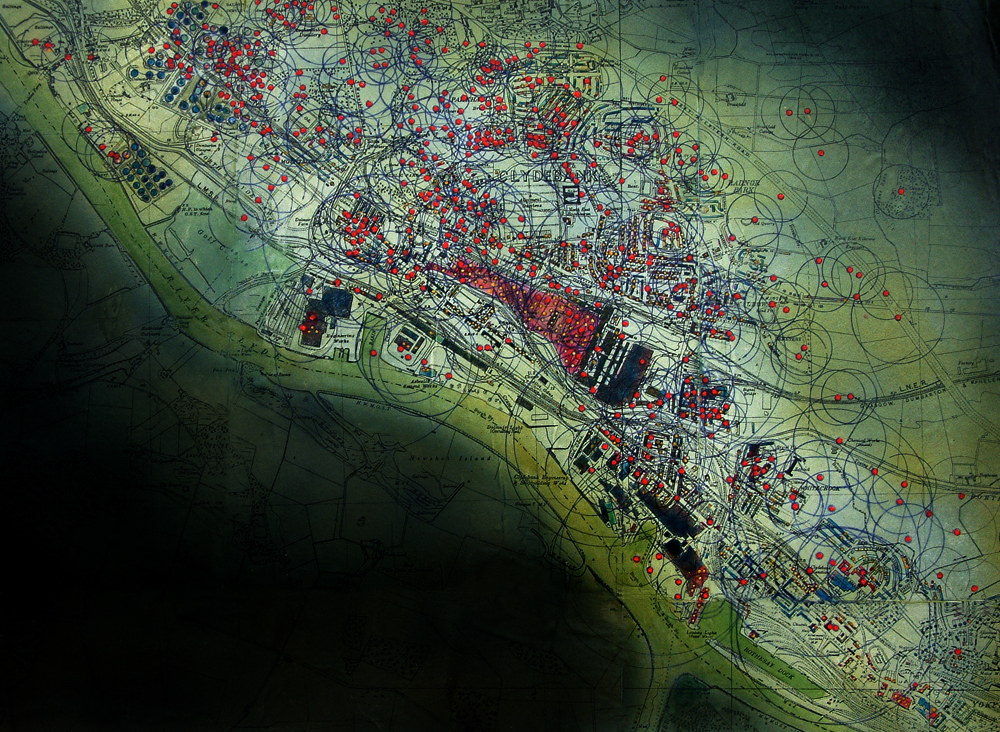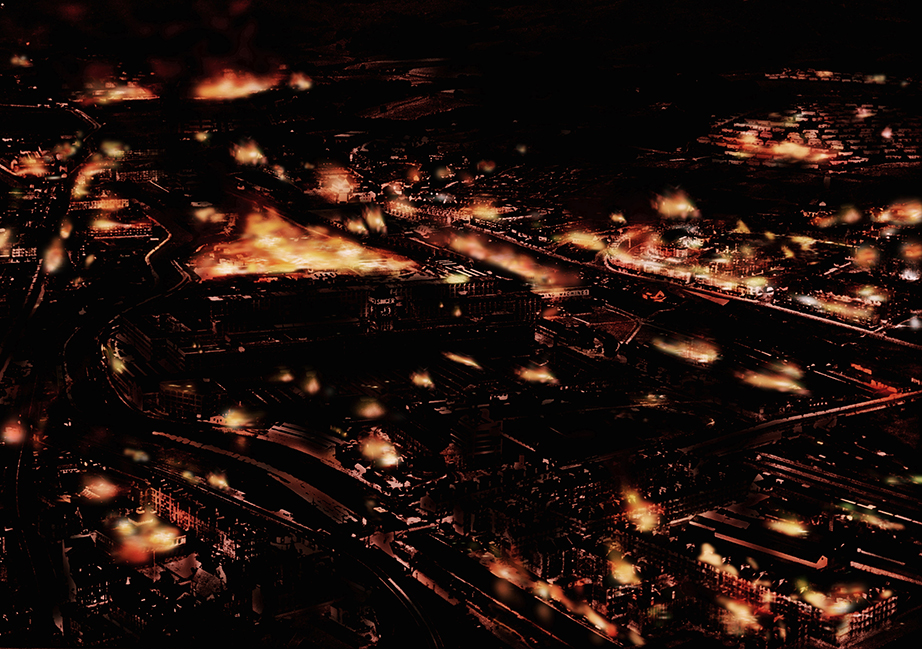CLYDEBANK BLITZ BOMB MAP

This map, compiled and designed by Tom McKendrick in 1983, is included as part of the artist’s research for the paintings titled “Map” It shows the town of Clydebank as it was in 1941 and contains detailed information of the damage caused by the raids on 13th and 14th March.
It serves to illustrate the accuracy and concentration of the attack The circles that surround the red bomb hits indicate the explosive category of individual bombs and are drawn at ‘severe blast damage diameter’. The smaller rings indicate 50kg bombs, and progressively, 250 kg bombs and 500kg bombs. The largest rings, ’Parachute Mines’, weighing almost 1 metric ton, had a severe blast damage radius of 400 yards.
Thousands of incendiaries fell in the target area. Incendiary damage is shown by yellow spots. These do not indicate individual incendiaries but buildings destroyed by incendiary devices. In total only 7 houses out of a stock of 12,000 remained undamaged. Approximately 4,000 destroyed, 4,500 severely damaged and 3,500 in the serious to minor damage category.
In total 400 high explosive bombs and mines fell on the town. 96 high explosive bombs fell on the primary target, the oil tanks at Dalnottar to the West of the town and 190 bombs fell in the boundaries of the nearby villages of Duntocher, Hardgate, Bowling and Old Kilpatrick. 132 bombs fell in the Kilpatrick hills, aimed at decoy fires West of Cochno.
The greatest damage was caused by incendiaries. On the first night of the raid 1,630 containers of incendiary bombs were dropped by the Luftwaffe. On the second night 782 containers were dropped. Incendiary numbers are difficult to calculate. Unless an aircraft was fully loaded with incendiary bombs, it was the general practice to load aircraft to their ‘large bomb’ carrying capabilities with high explosive bombs then fill the remaining capacity with incendiaries.
To accommodate this practice incendiary containers ranged in weight from the AB36 containing 36 1kg bombs to the BSB 700 containing 702 1kg bombs. If the smallest container, AB 36, is multiplied by the number of containers stated in Luftwaffe records it equals a minimum of 86,832 1kg incendiaries. In Dr MacPhail’s ‘Clydebank Blitz’ book he makes reference to information that all incendiary containers were AB 250 containing 250 1Kg bombs. This would calculate as a total of 603,000 1kg incendiaries. According to German sources a total of 503 metric tons of high explosive bombs and 2,412 containers of incendiaries were dropped on Clydeside on the 13th and 14th March 1941. A total of 439 aircraft took part in the raids.


Clydebank on the evening of 13/14 th March 1941. A computer generated image based on the photograph above and incendiary damage reports. The image covers the area of the town highlighted. The fires at Beardmore’s Factory, the Ordinance Factory, John Browns Shipyard, Rothesay Dock and the Yoker Distillery and the extensive fires in the Bannerman Street, Livingston Street and Kilbowie Road area are not included. Not illustrated are the 270 high explosive bombs and mines fell in the same map area.
The large confligration in the centre of the image was caused by the igniting of a vast stock of timber stored at Singers Factory in connection with the war effort. While the exact volume of timber is unknown the yard was filled with both factory and governement stock. The site covered 40 acres and was completely destroyed.
Perhaps one of the great injustices of the Clydebank Blitz was the superceeding of the towns firemaster Robert Buchanan for his handling of the conflagration, by Lord Rosbery, Scottish Regional Commissioner for Civil Defence.
Early in the raid 6 yards of Clydebanks 15 inch primary water main was blow out. A 10 inch and 12 inch water main were blown out by delayed action bombs. The 6 inch water main serving the Dalmuir area was blown out in 2 places. Clydebank’s 3 auxiliary fire stations were bombed and rendered useless. Only the central station remained in operation. Immediate assistance by outside services was made almost impossible by craters and collapsed buildings.
The few fire fighting units that initially accessed the town could not fully function as no standardisation of fire fighting hose fittings existed 1941, water having to be drawn from the Forth and Clyde canal to fight fires. 65 major units were eventually brought in and by the afternoon of the 14th it was obvious the fires could not be brought under control before the second wave of bombers arrived. It was clear to many that Buchanan had been made a scapegoat for the disaster as it was readily admitted that no firemaster or fire service could have coped with the inferno. Buchanan resigned and sadly died 7 months later after a serious illness.